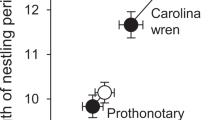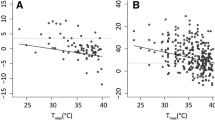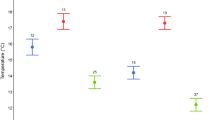Abstract
Among many functions, bird nests protect eggs, developing young, and incubating adults from inclement weather. In Tree Swallows (Tachycineta bicolor), prior to and while females are incubating, males compete with rivals for feathers that they use to line nests. The thermal benefits hypothesis proposes that males add feathers to improve heat retention of nests. We tested this hypothesis on Tree Swallows nesting near Wolfville, Nova Scotia, Canada in 2013, 2014, and 2015, and in St. Denis, Saskatchewan in 2013. In 2013, at both locations we experimentally heated nests. After young had fledged, we counted and measured feathers in each nest. The hypothesis was not supported. The only significant result was that St. Denis (52.2°N) had fewer feathers than the Annapolis Valley (45.1°N) site, which is contrary to expectation. Our findings challenge the prevailing hypothesis for why male Tree Swallows feather nests.
Zusammenfassung
Die Ausstattung des Nestes mit Federn als Reaktion auf experimentelle Erwärmung bei Sumpfschwalben (Tachycineta bicolor)
Neben vielen anderen Funktionen schützen Vogelnester Gelege und die sich entwickelnden Küken sowie die brütenden Altvögel vor schlechten Witterungsbedingungen. Vor und während der Bebrütung durch die Weibchen konkurrieren die Männchen der Sumpfschwalben (Tachycineta bicolor) mit Rivalen um Federn, die sie zur Auskleidung ihrer Nester benutzten. Nach der Thermal Benefits-Hypothese fügen Männchen den Nestern Federn hinzu, um das Wärmerückhaltevermögen der Nester zu verbessern. Wir testeten diese Hypothese an brütenden Sumpfschwalben nahe Wolfville, Nova Scotia, Kanada, in den Jahren 2013, 2014, 2015 und in St. Denis, Saskatchewan, Kanada, in 2013. In 2013 erwärmten wir in beiden Untersuchungsgebieten die Nester. Nach dem Ausfliegen der Jungen haben wir in jedem Nest die Federn gezählt und sie vermessen. Die Hypothese wurde nicht gestützt. Das einzige signifikante Ergebnis war, dass die Nester in St. Denis (52.2°N) weniger Federn hatten als in dem Gebiet im Annapolis Valley (45.1°N), was der Erwartung widersprach. Unsere Ergebnisse stellen die vorherrschende Hypothese in Frage, warum Sumpfschwalben Männchen ihre Nester mit Federn ausstatten.


Similar content being viewed by others

References
Álvarez E, Belda EJ, Verdejo J, Barba E (2013) Variation in Great Tit nest mass and composition and its breeding consequences: a comparative study in four Mediterranean habitats. Avian Biol Res 6:39–46. https://doi.org/10.3184/175815513X13609517587237
Ardia DR (2007) The ability to mount multiple immune responses simultaneously varies across the range of the Tree Swallow. Ecography 30:23–30. https://doi.org/10.1111/j.0906-7590.2007.04939.x
Ardia DR, Pérez JH, Clotfelter ED (2006) Nest box orientation affects internal temperature and nest site selection by Tree Swallows. J Field Ornithol 77:339–344. https://doi.org/10.1111/j.1557-9263.2006.00064.x
Austin GT (1974) Nesting success of the Cactus Wren in relation to nest orientation. Condor 76:216–217
Austin OL, Low SH (1932) Notes on the breeding of the Tree Swallow. Bird Band 3:39–44
Bent AC (1963) Tree Swallow. Life histories of North American flycatchers, larks, swallows, and their allies. Dover, New York, pp 384–399
Betini GS, Norris DR (2012) The relationship between personality and plasticity in Tree Swallow aggression and the consequences for reproductive success. Anim Behav 83:137–143. https://doi.org/10.1016/j.anbehav.2011.10.018
Bicudo JEPW, Buttermer WA, Chappell MA et al (2010) Adaptations: developmental physiology. Ecological and environmental physiology of birds. Oxford University Press, Oxford, pp 208–225
Bitton P-P, O’Brien EL, Dawson RD (2007) Plumage brightness and age predict extrapair fertilization success of male Tree Swallows, Tachycineta bicolor. Anim Behav 74:1777–1784. https://doi.org/10.1016/j.anbehav.2007.03.018
Britt J, Deeming DC (2011) First-egg date and air temperature affect nest construction in Blue Tits Cyanistes caeruleus, but not in Great Tits Parus major. Bird Study 58:78–89. https://doi.org/10.1080/00063657.2010.524916
Burtt EH, Tuttle RM (1983) Effect of timing of banding on reproductive success of Tree Swallows. J Field Ornithol 54:319–323. https://doi.org/10.2307/4512841
Cohen RR (1985) Capturing breeding male Tree Swallows with feathers. N Am Bird Band 10:18–21
Collias EC, Collias NE (1984) Nest building and bird behavior. Princeton University Press, Princeton
Crawley MJ (2005) Statistics: an introduction using R. Wiley, West Sussex
Custer CM, Custer TW, Hines JE et al (2007) Adult Tree Swallow (Tachycineta bicolor) survival on the polychlorinated biphenyl-contaminated Housatonic river, Massachusetts, USA. Environ Toxicol Chem 26:1056–1065. https://doi.org/10.1897/06-337R.1
Dawson RD, Lawrie CC, O’Brien EL (2005) The importance of microclimate variation in determining size, growth and survival of avian offspring: experimental evidence from a cavity nesting passerine. Oecologia 144:499–507. https://doi.org/10.1007/s00442-005-0075-7
Deeming DC, Mainwaring MC, Hartley IR, Reynolds SJ (2012) Local temperature and not latitude determines the design of Blue Tit and Great Tit nests. Avian Biol Res 5:203–208. https://doi.org/10.3184/175815512X13528874959581
Dunn PO, Robertson RJ, Michaud-Freeman D, Boag PT (1994) Extra-pair paternity in Tree Swallows: why do females mate with more than one male? Behav Ecol Sociobiol 35:273–281. https://doi.org/10.2307/4601010
Dunn PO, Thusius KJ, Kimber K, Winkler DW (2000) Geographic and ecological variation in clutch size of Tree Swallows. Auk 117:215–221. https://doi.org/10.1642/0004-8038(2000)117[0215:GAEVIC]2.0.CO;2
Environment Canada (2013) National climate data and information archive. National climate data and information archive. http://www.climate.weatheroffice.gc.ca/Welcome_e.html. Accessed 3 Sept 2014
Facemire CF, Facemire ME, Facemire MC (1990) Wind as a factor in the orientation of entrances of Cactus Wren nests. Condor 92:1073–1075. https://doi.org/10.2307/1368745
Fast M (2007) Climate variability, timing of nesting and breeding success of Tree Swallows (Tachycineta bicolor). MSc thesis, University of Saskatchewan
Forbush EH (1929) Tree Swallow. Birds of Massachusetts and other New England states. Massachusetts Department of Agriculture, Berwick and Smith, Boston, pp 153–158
Hainstock MH, Smith MC, Carr J, Shutler D (2010) Parental investment and brood value in Tree Swallows, Tachycineta bicolor. Behaviour 147:441–464. https://doi.org/10.1163/000579509X12580070671323
Hilton GM, Hansell MS, Ruxton GD et al (2004) Using artificial nests to test importance of nesting material and nest shelter for incubation energetics. Auk 121:777–787. https://doi.org/10.1642/0004-8038(2004)121[0777:UANTTI]2.0.CO;2
Hussell DJT (1983) Age and plumage color in female Tree Swallows. J Field Ornithol 54:312–318
Jensen-Jarolim E (ed) (2013) 7.1.4 birds. In: Comparative medicine: anatomy and physiology. Springer, Vienna, pp 107–108
Knight SM, Bradley DW, Clark RG, et al (2018) Constructing and evaluating a continent-wide migratory songbird network across the annual cycle. Ecol Monogr. https://doi.org/10.1002/ecm.1298
Lack D (1954) Losses of eggs and young. The natural regulation of animal numbers. Oxford University Press, London, pp 74–87
Liljesthröm M, Schiavini A, Reboreda JC (2009) Chilean swallows (Tachycineta meyeni) adjust the number of feathers added to the nest with time of breeding. Wilson J Ornithol 121:783–788. https://doi.org/10.1676/09-018.1
Lombardo MP (1994) Nest architecture and reproductive performance in Tree Swallows (Tachycineta bicolor). Auk 111:814–824. https://doi.org/10.2307/4088813
Lombardo MP, Bosman RM, Faro CA et al (1995) Effect of feathers as nest insulation on incubation behavior and reproductive performance of Tree Swallows (Tachycineta bicolor). Auk 112:973–981. https://doi.org/10.2307/4089028
Lozano GA, Perreault S, Lemon RE (1996) Age, arrival date and reproductive success of male American Redstarts Setophaga ruticilla. J Avian Biol 27:164–170. https://doi.org/10.2307/3677146
MacCulloch K (2004) Nest box selection in Tree Swallows (Tachycineta bicolor). BSc (Hons), Acadia University
Maderson PFA (2003) Mammalian skin evolution: a reevaluation. Exp Dermatol 12:233–236. https://doi.org/10.1034/j.1600-0625.2003.00069.x
Magnusson A (1984) A new method for catching birds breeding in nest boxes. Vår Fågelvärld 4:318
Mainwaring MC, Hartley IR, Bearhop S et al (2012) Latitudinal variation in Blue Tit and Great Tit nest characteristics indicates environmental adjustment: latitude and avian nest characteristics. J Biogeogr 39:1669–1677. https://doi.org/10.1111/j.1365-2699.2012.02724.x
McCarty JP (2001) Variation in growth of nestling Tree Swallows across multiple temporal and spatial scales. Auk 118:176–190. https://doi.org/10.1642/0004-8038(2001)118[0176:VIGONT]2.0.CO;2
McGowan A, Sharp SP, Hatchwell BJ (2004) The structure and function of nests of Long-tailed Tits Aegithalos caudatus. Funct Ecol 18:578–583
Mertens JAL (1977) Thermal conditions for successful breeding in Great Tits (Parus major L.). Oecologia 28:1–29. https://doi.org/10.1007/BF00346834
Muldal A, Gibbs HL, Robertson RJ (1985) Preferred nest spacing of an obligate cavity-nesting bird, the Tree Swallow. Condor 87:356–363. https://doi.org/10.2307/1367216
Nager RG, Monaghan P, Houston DC (2000) Within-clutch trade-offs between the number and quality of eggs: experimental manipulations in gulls. Ecology 81:1339–1350. https://doi.org/10.1890/0012-9658(2000)081[1339:WCTOBT]2.0.CO;2
Nice MM (1957) Nesting success in altricial birds. Auk 74:305–321. https://doi.org/10.2307/4081922
Olson CR, Vleck CM, Vleck D (2006) Periodic cooling of bird eggs reduces embryonic growth efficiency. Physiol Biochem Zool 79:927–936. https://doi.org/10.1086/506003
Reid JM, Monaghan P, Ruxton GD (2000) Resource allocation between reproductive phases: the importance of thermal conditions in determining the cost of incubation. Proc Biol Sci 267:37–41. https://doi.org/10.1098/rspb.2000.0963
Reid JM, Cresswell W, Holt S et al (2002) Nest scrape design and clutch heat loss in Pectoral Sandpipers (Calidris melanotos). Funct Ecol 16:305–312. https://doi.org/10.1046/j.1365-2435.2002.00632.x
Ringelman K (2007) Aerial competition for feathers by Tree Swallows (Tachycineta bicolor). BSc (Hons), Cornell University
Rohwer VG, Law JSY (2010) Geographic variation in nests of yellow warblers breeding in Churchill, Manitoba, and Elgin, Ontario. Condor 112:596–604. https://doi.org/10.1525/cond.2010.090229
Royama T (1969) A model for the global variation of clutch size in birds. Oikos 20:562–567. https://doi.org/10.2307/3543221
Scarazzini D (1999) Helping a grounded baby bird. In: Helping orphaned or injured wild birds. Storey, North Adams, p 8
Sheppard CD (1977) Breeding in the Tree Swallow (Iridoprocne bicolor) and its implications for the evolution of coloniality. Ph.D. dissertation, Cornell University
Shutler D, Clark RG (2003) Causes and consequences of Tree Swallow (Tachycineta bicolor) dispersal in Saskatchewan. Auk 120:619–631
Shutler D, Clark RG, Fehr C, Diamond AW (2006) Time and recruitment costs as currencies in manipulation studies on the costs of reproduction. Ecology 87:2938–2946. https://doi.org/10.1890/0012-9658(2006)87[2938:TARCAC]2.0.CO;2
Shutler D, Norris D, Winkler D et al (2012) Spatiotemporal patterns in nest box occupancy by Tree Swallows across North America. Avian Conserv Ecol 7:3. https://doi.org/10.5751/ACE-00517-070103
Sibley DA (2001) Swallows and martins. The Sibley guide to bird life and behaviour. Knopf, New York, pp 419–424
Slagsvold T, Lifjeld JT (1990) Influence of male and female quality on clutch size in tits (Parus spp.). Ecology 71:1258–1266. https://doi.org/10.2307/1938263
Stutchbury BJ, Robertson RJ (1988) Within-season and age-related patterns of reproductive performance in female Tree Swallows (Tachycineta bicolor). Can J Zool 66:827–834. https://doi.org/10.1139/z88-122
Tufts RW (1986) Swallows—Tree Swallow. Birds of Nova Scotia, 3rd edn. Nimbus, Halifax, pp 290–292
Welty JC (1982) Nests. The life of birds, 3rd edn. Saunders College, New York, pp 314–347
White FN, Kinney JL (1974) Avian incubation. Science 186:107–115
Wiebe KL, Swift TL (2001) Clutch size relative to tree cavity size in Northern Flickers. J Avian Biol 32:167–173. https://doi.org/10.1034/j.1600-048X.2001.320210.x
Winkler DW (1993) Use and importance of feathers as nest lining in Tree Swallows (Tachycineta bicolor). Auk 110:29–36
Winkler DW, Hallinger KK, Ardia DR, et al (2011) Tree Swallow (Tachycineta bicolor) version 2.0. The birds of North America online. In: Rodewald PG (ed) Cornell Lab of Ornithology, Ithaca. https://doi.org/10.2173/bna.11. Accessed 2 Nov 2017
Yunick RP (1990) Some banding suggestions at nest boxes. N Am Bird Band 15:146–147
Acknowledgements
We thank in particular the landowners for allowing us to maintain nest boxes on their properties Danielle Fife, Giselle Deane, Lewis Mahon, and Ellen Boyd for help deploying heating pads in 2013. Special thanks to Madeline Sutton, who was a daily presence in 2013. Thanks also to Trevor Avery, Kirk Hillier, and especially Ed Reekie for the use of their temperature loggers. Bob Clark and Alexandra Grossi sent us nests from Saskatchewan, and Graham Fairhurst provided insight into methods. We thank Trevor Avery and Danielle Quinn for assistance with statistical analyses. A number of anonymous reviewers provided valuable comments that significantly improved the manuscript.
Author information
Authors and Affiliations
Corresponding author
Ethics declarations
This study complies with the current laws of Canada. All applicable institutional guidelines for the use of animals were followed, with both the Acadia Animal Care Committee and the University of Saskatchewan Animal Care Committees having approved all research. All procedures performed were in accordance with the ethical standards of the institution at which the studies were conducted.
Conflict of interest
The authors declare that they have no competing interests.
Financial support
This research was funded by the Natural Sciences and Engineering Research Council of Canada and the Hunters and Trappers of Nova Scotia (via their Habitat Conservation Fund). None of the funders had any input into the content of the manuscript, nor required approval of the manuscript prior to submission or publication.
Additional information
Communicated by C. G. Guglielmo.
Appendices
Appendix 1: The recruitment probability hypothesis
The recruitment probability hypothesis proposes that males add more feathers to nests they judge to be of higher value (metrics described in Hainstock et al. 2010). Broods of such nests may be associated with higher quality females that invest more in individual eggs, that lay larger clutches, or that have more breeding experience raising clutches (Stutchbury and Robertson 1988), and males may add extra feathers to signal to females their future paternal care, or for heat retention (but see above). Progeny produced by these females are assumed to have a greater potential to contribute to a male’s Darwinian fitness. Males may assess female quality based on her age class, which in Tree Swallows can be evaluated using plumage characteristics, clutch initiation date [date that a first egg is laid, which is earlier for older females (Stutchbury and Robertson 1988) and is strongly associated with recruitment (Shutler et al. 2006)], and clutch size [which is strongly associated with lifetime reproductive success (Shutler et al. 2006)]. Although in Lesser Black-backed Gulls (Larus fuscus), larger clutch size is associated with lower quality eggs (Nager et al. 2000), in three tit species (Blue, Great, and Coal tits, Parus ater), clutch size determination of females is based on their own ability to feed their young and has nothing to do with mate quality, with lower quality females producing smaller clutches (Slagsvold and Lifjeld 1990). We are unaware of a study that has assessed whether brood value influences feathering.
In Nova Scotia in 2014, trios of nests initiated on the same day were randomly assigned to reduction (two eggs removed), control (two eggs picked up and replaced), or addition (two eggs added) treatments. Eggs from reduce clutches were placed in addition clutches. Modal clutch size in this population was five. We predicted that if we experimentally decreased and increased clutch size that males would add fewer and more feathers, respectively, because of changes in brood value. Similarly, we predicted that males would add fewer feathers to nests of younger females.
We used a GLM to test whether number of feathers and feather lengths were related to female age, clutch initiation date, and clutch size. Only 22 nests fledged from the clutch manipulation experiment, so that statistical comparisons among treatments had little power. Therefore, we simply considered feather number and feather lengths simultaneously for both manipulated and non-manipulated nests from all 3 years. Female age, clutch initiation date, and clutch size were not associated with feathering (Table 2). Results were qualitatively similar when experimental clutch manipulations were excluded.
We therefore found no support for the recruitment probability hypothesis, although our experimental power was low, with only eight of 11 manipulated nests successfully fledging. It is also possible that males may assess recruitment probability through metrics other than those we tested. Female Tree Swallows select males that have brighter plumage for extrapair copulations (Bitton et al. 2007) and it is possible that males use plumage brightness to assess female quality and hence brood value. Although we found no correlation between female age and number or length of feathers added by males, we did not evaluate plumage brightness within age classes. The mating system of Tree Swallows may also weaken selection for males to impress partners with feathering. First, Tree Swallows have one of the highest documented rates of extra-pair paternity in birds (Dunn et al. 1994). Second, Tree Swallows over most of their range have only a single clutch per year, and in fewer than 18% of cases do the same adults pair in successive years (Shutler and Clark 2003; Shutler et al. 2006; Winkler et al. 2011). In any case, our tests should be replicated with larger samples.
Appendix 2
See Table 3.
Rights and permissions
About this article
Cite this article
Holland, E.R., Shutler, D. Nest feathering responses by Tree Swallows (Tachycineta bicolor) to experimental warming. J Ornithol 159, 991–998 (2018). https://doi.org/10.1007/s10336-018-1568-6
Received:
Revised:
Accepted:
Published:
Issue Date:
DOI: https://doi.org/10.1007/s10336-018-1568-6



